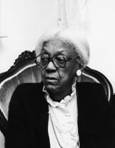|
|
|
|
|
|
|
Students-Excerpts From Many Voices : Mrs. Ola Corprew
|
|
|

Mrs. Ola Corprew
Mrs. Ola Corprew has a very vivid memory of her early school years. Her aunt, Augustus Smith, was also her teacher in the one-room Sandy Mount School. She later recalls a Dr. Thomas teaching her. A medical doctor, he and his wife lived near where Hill Street Parsonage is now. “They lived upstairs in those apartments, and I went to school to him,” she added. He taught all grades including 6th and 7th.
In earlier years, it was a common practice for the people of the community to donate the land, help build the school and in some instances pay the teacher and even bring firewood. Mrs. Corprew recalls that the property for the Sandy Mount School and church that was built on it was given by a minister called “Gentleman Tynes.” Mrs. Corprew recalls other one-room schools located in the area. “Jordan School was on a farm…a big farm off of what is now Route 258. You’d go down Tom Thomas’ Lane to that farm. They had the school there in a special building for the children of the family. There was another one-room school on Tom Thomas’ land nearer to highway 258. Later years it was called the Davis School, and the oldest daughter of Mr. Harrison Jordan, Lula Jordan, was the teacher. There was also Ebenezer, Holly Grove, Blooming Light and Bailey’s Schools.”
Mrs. Corprew recollects that the Bailey School was on farmland owned by Mr. William Bailey. He furnished the land, and building, but did not pay the teacher. Rather than deed the property to the county, he let them use it as a school for as long as they wished. When the school was later closed, he retained the land. This was not the case with other schools in which the donated land had to be purchased back from the county when the school was closed.
The school year was October through April, but Mrs. Corprew remembers that they sometimes only had school for three months. “That little school at Union Bethel—some of its people would go there maybe four months. Then that school would close and they would have school at Ebenezer A.M.E. Church for the spring months.” According to Mrs. Corprew, the explanation for this was “that they were trying to give children in different sections an opportunity to get some schooling. Some of the children were anxious and energetic and would go to school at Union Bethel and would later walk way to the Ebenezer School to study,” she recalled.
“The woods weren’t so thick then, so children walked to school. We had saw mills that had been through and had cut the big trees. We walked around the fences and went around a field ‘New Ground,’ to the locomotive track.” She remembers that they would often walk down the center of the track. Mrs. Corprew recollects vividly skirting around “the fence of the white man. Sometimes he didn’t mind us going across, but he kept standing there. Sometimes we would cross when we didn’t see the steer, but I was afraid of the steer, so we walked around rather than going through. We came out at a place called Addison’s farm. Then we would go on to the road from Addison’s Farm to Sandy Mount. Our parents were very strict. When we started home from school, we came all the way home. We couldn’t stop and play.”
School attendance varied. In the fall when the boys and girls were busy on the farm there might be as few as 25 to 30. In the winter time, during the cold and snow, “the big boys were able to come and there would be twice as many.” Since there was no work on the farm during that kind of weather, they would come to school for a couple of days and “bring those big geography books.”
The book Many Voices was published in 1986 as part of a project of the Interview Committee appointed in 1984 for the Isle of Wight County 350th Sesquitricentennial Celebration. The Oral History project taped the recollections of our older citizens and developed their stories from the transcriptions. Many Voices gave a permanent record of the previously unrecorded family life and history in Isle of Wight County. These excerpts take only the discussions dealing with the education memories of some of those citizens.
|
|
|
|
|
|
|
|
|
|
|
 |
Copyright 2016. The Schoolhouse Museum. Website developed by
WSI Login |
 |
|
|
|